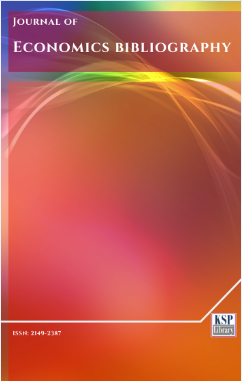Colonial coinage and financial development
Abstract
Abstract. Until the 21st century, Africa remains the only region in the world where there are countries whose currency is derived from the colonial system. Very far from political and geostrategic considerations, the question has always been asked in order to know the effect of this lack of monetary sovereignty on the evolution of economic activity. Therefore, this study investigates the relationship between Colonial coinage and financial development by applying Generalised Method of Moments. The importance of this approach, is to deal with heterogeneity and endogeneity problems. The sample consist of 48 African countries data over 10 years. This study findings are like-minded with those of economic literature around the law, finance and endowment theory. They suggest that in sub-Saharan Africa, the quality of institutions has a very large influence on access to domestic credit. Moreover, the main enclave for the development of the financial system due to colonial coinage is the sluggish stability of the latter colonial coinage in Africa.
Keywords. Colonial coinage, Cliometrics, Financial development, Institutions.
JEL. E50, G20, K40.Keywords
References
Bagehot, W. (1873). Lombard Street: A Description of the Money Market. London: H S King.
Basmann, L. (1957). A generalized classical method of linear estimtion of coefficients in a structural equation. Econometrica, 25(1), 77-83. doi. 10.2307/1907743
Bebchuk, L.A. (1994). Efficient and Inefficient Sales of Corporate Control. Quaterly Journal of Economics, 109(4), 957-993. doi. 10.2307/2118353
Beck, T., Demirgüc-Kunt, A., & Levine, R. (2003). Law, endowments, and finance. Journal of Financial Economics, 70(2), 137–181. doi. 10.1016/S0304-405X(03)00144-2
Bekolo-Ebe, B. (2002). Les défis de l'intermédiation financière en Afrique. In B.-E.B (Ed.), intermédiation financière et financement du développement en Afrique (pp.13-25). Yaoundé: Presse Universitaire de Yaoundé.
Bencivenga, V., & Smith, B. (1991). Financial intermediation and endogenous growth. Review of Economic Studies, 58(2), 195-209. doi. 10.2307/2297964
Blundell, R., & Bond, S. (1998). Initial conditions and moment restrictions in dynamic panel data models, Journal of Econometrics, 87(1), 115-143. doi. 10.1016/S0304-4076(98)00009-8
Demirguc-Kunt, A., & Maksimovic, V. (1998). Law, finance and firm growth. Journal of Finance, 53(6), 2107-2138. doi. 10.1111/0022-1082.00084
Ebeke, C., Omgba, L., & Laajaj, R. (2015). Oil, governance and the (mis)allocation of talent in developing countries, Journal of Development Economics, 114, 126–141. doi. 10.1016/j.jdeveco.2014.12.004
Galbis, V. (1977). Financial intermediation and economic growth in less-developed countries: A theorical approach. Journal of Development Studies, 13(2), 58-72. doi. 10.1080/00220387708421622
Greene, W. H. (2002). Econometric Analysis. New York: Prentice Hall.
Gromb, D. (1993). Is one-share one-vote optimal? London School of Economics. [Retrieved from].
Gurley, J., & Shaw, E. (1955). Financial aspect of economic development. American Economic Review, 45(4), 515-538.
Hansen, L. (1982). Large sample properties of generalized method of moments estimators. Econometrica, 50(4), 1029-1054. doi. 10.2307/1912775
Harris, M., & Raviv, A. (1988). Corporate government: Voting rights and majority rules. Journal of Financial Economics, 20, 203-235. doi. 10.1016/0304-405X(88)90045-1
Hicks, J. (1969). A Theory of Economic History. Oxford Clarendon Press.
Kapur, B.K. (1976). Alternative stabilization policies for less-developed economies. Journal of Political Economics, 84(4), 777-795. doi. 10.1086/260476
Kpodar, K.R., & jeanneney, S.G. (2004). Le développement financier et la problématique de réduction de la pauvreté. Economie & Prevision, 174, 87-111. doi. 10.3406/reco.1994.409564
Kuznets, S. (1955). Economic growth and income inequality, The American Economic Review, 45(1), 1-28.
La Porta, R., Lopez-de-Silanes, F., & Shleifer, A. (2008). The economic consequences of legal origins. Journal of Economic Literature, 46(2), 285–332. doi. 10.1257/jel.46.2.285
Laporta, R., Lopes-de-Silanes, F., Shleifer, A., & Vishny, R.W. (1998). Law and finance. The Journal of Political Economy, 106(6), 1113-1155. doi. 10.1086/250042
Levchenko, A.A., & Di Giovanni, J. (2008). Trade openness and volatility. IMF Working Paper, No.2008/146. doi. 10.5089/9781451870046.001
Levine, R. (1997). Financial development and economic growth: views and agenda. Journal of Economic Literature, 35(2), 688–726.
Liu, Q., Hua, R., & An, Y. (2016). Determinants and information content of intraday bid-ask spreads: Evidence from Chinese commodity futures markets. Pacific-Basin Finance Journal, 38, 135-148. doi. 10.1016/j.pacfin.2016.04.002
Lucas, R. (1988). On the mechanics of economic development. Journal of Monetary Economics, 22(1), 3–42. doi. 10.1016/0304-3932(88)90168-7
Mathieson, R.J. (1980). Financial reform and stabilization policy in a developing economy. Journal of Development Economics, 7(3), 359-395. doi. 10.1016/0304-3878(80)90017-6
McKinnon, R.I. (1973). Money and Capital in Economic Development. Washington DC: The Brooking Institutions.
North, D.C., Summerhill, W., & Weingast, B. (1998). Order, disorder and economic change: Latin America vs. North America. Unpublished manuscript, Hoover Institution, Stanford University.
North, D., & Weingast, B. (1989). Constitutions and commitment: the evolution of institutions governing public choice in seventeenth-century England. Journal of Economic History, 49(4), 803–832. doi. 10.1017/S0022050700009451
Nzomo, J., & Dombou, D. (2017). Stock markets, volatility and economic growth: evidence from Cameroon, Ivory Coast and Nigeria. Panorama Economico, 12(24), 145-175.
Olsson, M. (1993, September). Dictatorship, democracy and development. The American Political Science Review, 87(3), 567-576. doi. 10.2307/2938736
Patrick, H. (1966). Financial development and economic growth in underdeveloped countries. Economic Development and Cultural Change, 14(2), 174-189. doi. 10.1086/450153
Robinson, J. (1952). The Rate of Interest and O/He. London: McMillan.
Sargan, J. (1958). The estimation of economic relationships using instrumental variables, Economica, 26, 393-415. doi. 10.2307/1907619
Schumpeter, J.A. (1911). The Theory of Economic Development.
Shaw, E. S. (1973). Financial Deepening in Economic Development. Oxford University Press.
Taylor, L. (1983). Structuralist Macroeconomics: Applicable Models for the Third World. New York.
Theil, H. (1953). Repeated least squared applied to complete equation systems. Unpublished manuscript, Central Planning Bureau, The Hague.
Van Wijnbergen, S. (1983). Credit policy, inflation and growth in a financially repressed economy. Journal of Development Economics, 13(1), 45-65. doi.10.1016/0304-3878(83)90049-4
Zmile, E. (2008). Le système financier haitien: La problématique du crédit au secteur privé face aux défis de croissance économique (1986-2005). Working Paper. [Retrieved from].
DOI: http://dx.doi.org/10.1453/jeb.v7i4.2154
Refbacks
- There are currently no refbacks.
.......................................................................................................................................................................................................................................................................................................................................
Journal of Economics Bibliography - J. Econ. Bib. - JEB - www.kspjournals.org
ISSN: 2149-2387.
Editor: jeb@ksplibrary.org Secretarial: secretarial@ksplibrary.org Istanbul - Turkey.
Copyright © KSP Library

